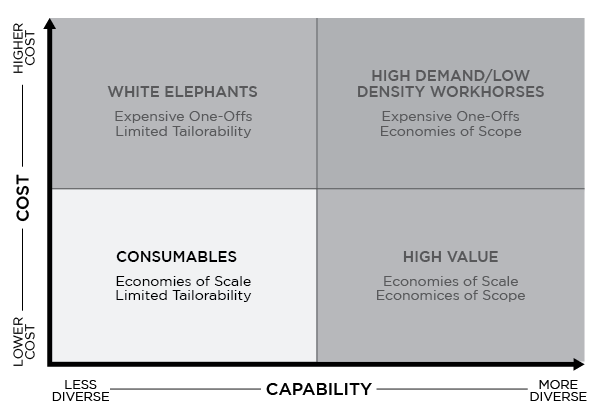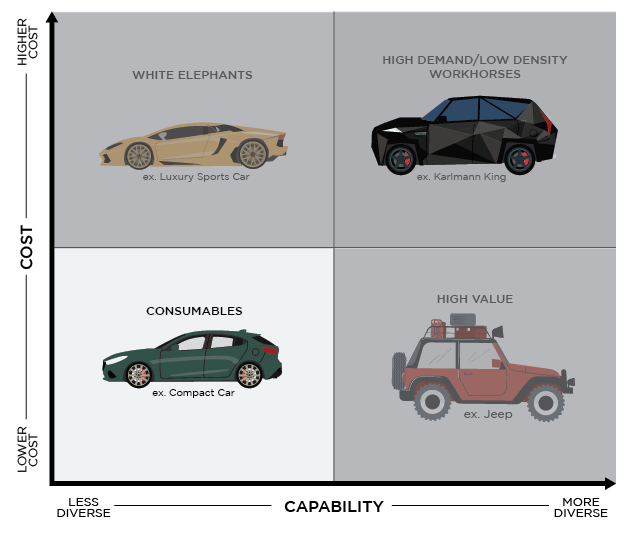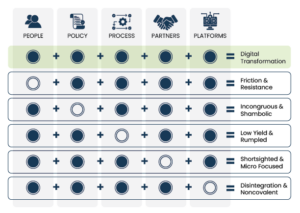Decision-makers face tough cost-capability dilemmas whenever charting strategic plans or evaluating investments. Whether debating budget allocations, analyzing procurement choices, or guiding technology adoption, leaders constantly balance fiscal prudence against pursuing advanced functionalities.
Did you miss part 1 of this series?
Read it here: Part 1 Intro to the Cost Capability Matrix
On one hand, sticking to bare essentials and proven offerings seems safest given constraints around taxpayer dollars, shareholder responsibilities or operating budgets. However, declining to invest in cutting-edge innovations risks ceding strategic advantages to those embracing new paradigms and capabilities. Such tradeoff analyses typically rely more on subjectivity than objectivity.
In decision-making processes, the challenge lies in balancing value and outcomes while avoiding excessive complexity, expenditure, or stretching beyond means. It is common for organizations to mistakenly associate affordability with a lack of progress or compromise in performance. However, not every investment requires cutting-edge capabilities. Mature solutions, adapted for scalability, can address immediate challenges while freeing up resources for high-risk, high-reward endeavors in the future.

Insights into Consumables
Quadrant 1 of the cost-capability matrix focuses on “consumables” – innovations optimized to deliver essential, affordable value rather than peak performance. These solutions cater to the pragmatic majority who prioritize price and necessity over prestige. Examples include reliable procurement vehicles, efficient mobile banking apps, and simple social platforms. This approach reflects a return to basics.
What distinguishes consumables is their emphasis on scalability and simplicity rather than specifications and customization. By maximizing production volume and streamlining features, consumables achieve low per unit costs, making them accessible to the mass market. Although they may not be attention-grabbing, consumables’ stripped-down approach and efficient operations fulfill their purpose: providing foundational capabilities to the mainstream at the lowest viable price point.
However, the notion of compromise is gradually losing relevance even in the low-cost consumables market. A new wave of ambitious startups now integrates surprisingly robust features into everyday products that were previously limited to meeting essential needs. For instance, robot vacuum cleaners now incorporate clever lidar sensors, budget smartphones run capable machine learning algorithms, and affordable headsets offer remarkably immersive virtual reality experiences. The line between premium and budget offerings is becoming increasingly blurry.

This democratization of once high-end technology to mass market consumables presents tremendous opportunities, but it also raises the level of competition. Both established industry leaders and disruptive newcomers realize that a significant portion of their potential market seeks to fulfill basic requirements at affordable prices. By catering to this segment, they gain early access to customers in the adoption lifecycle, cultivating loyalty and increasing lifetime value.
Therefore, consumables deserve just as much innovation, iteration, and investment as their more sophisticated counterparts. Proper positioning of consumables requires insight and vision, as the capabilities they offer become the baselines that end users come to expect as standard. Underestimating this segment by equating affordability with a lack of progress risks losing significant portions of the market to new entrants that provide unexpected value at disruptively low prices.
Practical Application
Leaders can harness Quadrant 1’s lens to identify capability gaps in existing consumable solutions aligned to basic organizational needs. Plotting current offerings on the cost-capability matrix quickly reveals commoditized areas demanding new attention amidst accelerating innovation cycles. Legacy systems residing in once-stable basic necessity niches now face disruption by scrappy entrants bundling advanced functionalities at radically low-price points. By analyzing the organizational consumables portfolio through the matrix, leaders gain urgency to re-examine lagging solutions against modern marketplace alternatives and user expectations in order to recapture neglected value chains before disruptors dominate commodity spaces ceded due to dated assumptions.
Questions a leader should consider:
- Are the basic, commoditized solutions in our organization still delivering the affordable value the Consumables quadrant seeks? Or could they be improved to better align with end-user needs and modern alternatives?
- What lower-cost stripped-down options available in the marketplace could offer similar base capabilities to replace any costly legacy consumables in our portfolio?
- How can we leverage economies of scale for these essential capabilities by consolidating contracts/vendors, increasing standardization, or improving production throughput?
- What underlying technologies, integrations, or processes could we enhance in our consumables to keep pace with competitors bundling advanced features into low-cost offerings?
- Do we have sufficient bench strength, partnerships, or in-house expertise across the organization’s various consumables to respond quickly if disrupted by cheaper or higher-value replacements?
- How frequently are we refreshing requirements and exploring alternative consumables relative to the pace of innovation in a given capability area? Are user needs and solution assumptions still aligned?
- What change management investments – organizational process changes, training, etc. – would be necessary if pivoting to faster cycle times and upgrades for our essential commodity solutions?
- Are capabilities in any supporting consumables limiting the potential usefulness or adoption ceiling of more advanced solutions my organization offers?
Asking these tough questions allows leaders to proactively address potential capability gaps, disruption risks, slower upgrade cycles, and feature creep even in basic consumable building blocks many institutions take for granted.
In the race to capture emerging value chains, the gloves are clearly off when it comes to consumables. Forget glossy packaging or prestige pricing – the goods hiding in plain sight often end up underpinning household brands. Behind the modest exterior lie immense possibilities for those clever enough to unlock consumables’ full potential. We’ll continue our analysis of each quadrant, looking into Quadrant 2: White Elephants next.





